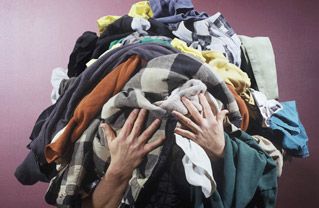Pushing the world to the limit
I like most people love to spend my weekends hitting the shops, keeping my eyes peeled for a bargain. But without realising I like most people have been contributing to one of the world’s biggest environmental crises facing the world today. After coal and oil, the fashion industry is the world’s largest polluter and is moving the world ever closer to the brink of irreversible damage.
It was only until I watched Stacey Dooley’s latest documentary on BBC1 Fashion’s Dirty Secrets that I was educated on the devastating impact cheap mass-produced clothes are having. My initial reaction was complete shock; firstly, at how clothes production could have such a big impact and secondly how unaware and uneducated the public is on the matter.
genuinely shocked by the documentary on how the fashion industry is complicit in worldwide extreme pollution via dirty water used in cotton, in Indonesia, Bangladesh, China, Mexico and Eastern Europe….. it's not just plastic that should worry us
— Mark Whiteley (@markwhiteley14) October 10, 2018
In light of my ignorance I was inspired to do my own research to look at how bad the problem really is and to hopefully shed some further light on an issue individuals like Stacey Dooley are already working hard to publicise.
It was in the 1980s that fast fashion as we know it today really took off, with factories working against the clock to mass-produce the latest styles that were being seen on the catwalk. Over time, this has grown exponentially with the high street full of affordable clothes and bargains. This quick turn over of new clothes items is then mirrored by the consumers (us) with the average person spending £1042 a year on new clothes even though we wear only 20% of our wardrobes.
Cheap for the wallet; expensive for the planet
Surprisingly cotton, one of the most-used materials in the production of clothes has one of the largest environmental impacts. This is perhaps most true in the impact cotton farms near the Kazakhstan -Uzbekistan border have had on the surrounding area which is picked up on in the BBC documentary. Cotton production has caused the Aral Sea to dry up which once covered an area of 26,300 square miles. This transformation took less than 40 years to occur.
Not only does cotton require large volumes of water, the crop also requires pesticides for protection during growth. These pesticides when entering the water can have health implications for communities living close to the water source. There are known reports of birth defects in children of Indian cotton planters.
Problematically as crops become resistant to the latest pesticides stronger ones are used which are only more damaging to the environment and humans.
Other materials also have a shocking impact. Polyester for example shed microfibres when washed. As they pass through a washing machine system they eventually make it way to the ocean where it is consumed by small fish like plankton. In the long term it works its way up the food chain to humans adding to the health problems experienced by people as a result of fashion.
Looking to the future
My motivation for writing this article was not to make people feel bad for their shopping habits – I am the first to admit I am contributing to this problem. I would recommend everyone to watch Stacey Dooley’s documentary and to do their own research to understand the role we are all playing as I doubt anyone would come away without being horrified at what is happening on an unprecedented scale.
Looking to the future it is important we all try and make small changes where we can. Doing things like only buying clothes when you need them, wearing them as much as possible and refrain as much as possible from buying cheap mass-produced clothes can have an impact. Most importantly, put pressure on the authorities to exert their influence on fashion producers to lower their carbon footprint.
In the UK, discussions in Parliament began on this matter back in June and will hopefully lead to legislative change.
Too often people expect others to do the right thing and make a change but environmental problems is an issue affecting everyone. This makes it the responsibility of everyone. For now, the demand for fashion currently outweighs the environmental security of the planet as financial gain is worth more to people than a healthy environment that will survive for generations. However, if more is done by people like us to reduce pollution from fashion industries I hope in the future we can hope for a better, healthier world to live in.









